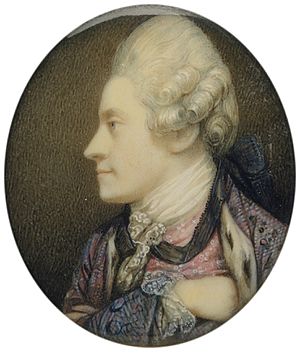Richard Cosway facts for kids
Quick facts for kids
Richard Cosway
|
|
|---|---|

Self-portrait in miniature, c. 1770
|
|
| Born | 5 November 1742 Tiverton, England
|
| Died | 4 July 1821 (aged 78) London, England
|
| Education | |
| Known for | Painter of portrait miniatures |
| Spouse(s) | |
Richard Cosway (born November 5, 1742 – died July 4, 1821) was a very important English artist. He was known for painting portraits during the Georgian and Regency era in England. He was especially famous for his tiny, detailed paintings called miniatures.
Cosway lived at the same time as other famous miniature painters like John Smart and George Engleheart. He was also friends with the poet and artist William Blake. Richard Cosway's wife was Maria Cosway, an artist from Italy. She was also a close friend of Thomas Jefferson, who later became a US President.
Contents
Early Life and Art Training
Richard Cosway was born in a town called Tiverton in Devon, England. His father was a school teacher. Richard first went to Blundell's School, where his father taught.
When he was twelve, he moved to London to learn how to paint. In 1754, soon after he arrived, he won an award from the Royal Society of Arts. He studied art with Thomas Hudson and William Shipley. By 1760, he had started his own art business.
He showed his first paintings in 1762 when he was only 20 years old. Soon, many people wanted him to paint their portraits.
Joining the Royal Academy
Richard Cosway was one of the first artists to join the Royal Academy. This is a famous art institution in London. He became an associate member in 1770. The next year, he became a full member. The president of the academy, Sir Joshua Reynolds, helped him get in.
You can even see Richard Cosway in a famous painting by Johan Zoffany. This painting shows many members of the Royal Academy together. Cosway was added to the painting a bit later, on an extra piece of canvas.
A Royal Artist
Richard Cosway painted a portrait of the future King George IV in 1780. Because of his talent, he was given a special title in 1785: "Painter to the Prince of Wales". This title was only given out once!
He painted many important people, including the Prince's first wife, Maria Anne Fitzherbert. He also painted many rich and important people from England and France, like Madame du Barry. She was a close friend of King Louis XV of France.
One of Cosway's students was an artist named Andrew Plimer.
From 1995 to 1996, the National Portrait Gallery in London had a special art show. It was called Richard and Maria Cosway: Regency Artists of Taste and Fashion. The show displayed 250 of their artworks.
Richard Cosway's Family Life

On January 18, 1781, Richard Cosway married Maria Hadfield. She was an artist from Italy. Maria was also a talented composer and musician. She was very interested in girls' education.
Maria was greatly admired by Thomas Jefferson. He even wrote letters to her and kept a picture of her painted by Richard Cosway.
Richard and Maria's marriage was probably planned by their families. Richard was 20 years older than Maria. Richard Cosway was known for his unique style and fancy clothes. He was often seen wearing a mulberry silk coat with red strawberries sewn on it!
In 1784, the Cosways moved into a large house called Schomberg House in Pall Mall. Their home became a popular place for London's high society to gather. They later moved to an even bigger house in 1791.
Richard Cosway had some health challenges later in his life. He passed away in London in 1821 and was buried at St Marylebone Parish Church. After he died, many of his valuable art pieces were sold.
Maria Cosway lived many years after Richard. She died in Italy in 1838. She had started a school for girls there. The emperor Francis I even made her a baroness in 1834 because of her dedication to educating girls.
Examples of Cosway's Work
-
Self-Portrait of Richard Cosway - National Portrait Gallery, London
-
Portrait of Arthur Wellesley, who later became the Duke of Wellington. Painted in 1808 by Richard Cosway. This miniature is at the Victoria and Albert Museum.
-
Portrait of an Armenian person.
-
John Braham with Harriet Abrams and her two daughters, Harriett Abrams and Theodosia Abrams.






